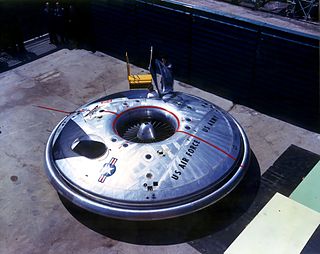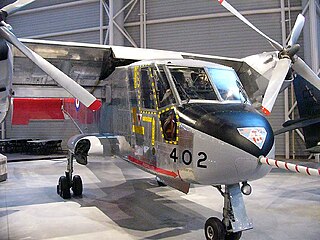| N 500 Cadet | |
|---|---|
 | |
| Role | VTOL research aircraft |
| National origin | France |
| Manufacturer | Nord Aviation Aérospatiale |
| First flight | July 1968 |
| Number built | 2 |
The Nord Aviation N 500 Cadet was a single-seat VTOL research aircraft built by Nord Aviation in 1967.
| N 500 Cadet | |
|---|---|
 | |
| Role | VTOL research aircraft |
| National origin | France |
| Manufacturer | Nord Aviation Aérospatiale |
| First flight | July 1968 |
| Number built | 2 |
The Nord Aviation N 500 Cadet was a single-seat VTOL research aircraft built by Nord Aviation in 1967.
A model kit presenting the concept was first shown at the Paris Air Show at Le Bourget in 1965. The aircraft was driven by two ducted fans, with three blades per fan, mounted on short wings that were able to pivot between providing vertical and horizontal thrust.
Two prototypes were constructed, one making its first (tethered) flight in July 1968.
General characteristics
Performance
Related lists

The Yakovlev Yak-38 was Soviet Naval Aviation's only operational VTOL strike fighter aircraft in addition to being its first operational carrier-based fixed-wing aircraft. It was developed specifically for, and served almost exclusively on, the Kiev-class aircraft carriers.

The Avro Canada VZ-9 Avrocar was a VTOL aircraft developed by Avro Canada as part of a secret U.S. military project carried out in the early years of the Cold War. The Avrocar intended to exploit the Coandă effect to provide lift and thrust from a single "turborotor" blowing exhaust out of the rim of the disk-shaped aircraft. In the air, it would have resembled a flying saucer.

The Canadair CL-84 "Dynavert", designated by the Canadian Forces as the CX-131, was a V/STOL turbine tiltwing monoplane designed and manufactured by Canadair between 1964 and 1972. Only four of these experimental aircraft were built with three entering flight testing. Two of the CL-84s crashed due to mechanical failures, with no fatalities occurring in either of the accidents. Despite the CL-84 being successful in the experimental and operational trials carried out between 1972 and 1974, none of the prospective customers placed any orders for the type.

The Ryan XV-5 Vertifan was a jet-powered V/STOL experimental aircraft in the 1960s. The United States Army commissioned the Ryan VZ-11-RY in 1961, along with the Lockheed VZ-10 Hummingbird. It successfully proved the concept of ducted lift fans, but the project was cancelled after multiple fatal crashes unrelated to the lift system.

The Dassault Mirage IIIV, also spelled Mirage III V, was a French vertical take-off and landing (VTOL) prototype fighter aircraft of the mid-1960s developed and produced by Dassault Aviation.

The Lockheed XFV was an American experimental tailsitter prototype aircraft built by Lockheed in the early 1950s to demonstrate the operation of a vertical takeoff and landing (VTOL) fighter for protecting convoys.

The Lockheed XV-4 Hummingbird was a U.S. Army project to demonstrate the feasibility of using VTOL for a surveillance aircraft carrying target-acquisition and sensory equipment. It was designed and built by the Lockheed Corporation in the 1960s, one of many attempts to produce a V/STOL vertical take off/landing jet. Both prototype aircraft were destroyed in accidents.

The Aérospatiale N 262 is a French twin-turboprop high-wing airliner built first by Nord Aviation. The aircraft was also known as the Nord 262.

The Dornier Do 31 is an experimental, jet-propelled, vertical take-off and landing (VTOL) cargo aircraft that was designed and produced by West German aircraft manufacturer Dornier.

The SNECMA C.450 Coléoptère was a tail-sitting vertical take-off and landing (VTOL) aircraft designed by the French company SNECMA and manufactured by Nord Aviation. While work on the aircraft proceeded to the test flying phase, the project never progressed beyond experimental purposes.

The Short SC.1 was the first British fixed-wing vertical take-off and landing (VTOL) jet aircraft. It was developed by Short Brothers. It was powered by an arrangement of five Rolls-Royce RB.108 turbojets, four of which were used for vertical flight and one for conventional horizontal flight. The SC.1 had the distinction of being the first British fixed-wing VTOL aircraft and the first one to transition between vertical and horizontal flight modes; it was also the first VTOL-capable aircraft with a fly-by-wire control system.

The Interstate Cadet was an American two-seat tandem, high wing, single-engine monoplane light aircraft. Around 320 of these aircraft were produced between the years 1941 and 1942 by the Interstate Aircraft and Engineering Corporation based in El Segundo, California. The construction techniques employed were a welded steel tube fuselage, wood (spruce) wing structure with metal ribs, and fabric covering, all of which were fairly standard in the 1940s.

The Sud Aviation/Aérospatiale SA-610 Ludion was a tiny, unorthodox VTOL aircraft demonstrated at the 1967 Paris Air Show. It consisted of little more than a chair, behind which were mounted two downward-pointing augmented rocket engines with control provided by thrust vectoring. The Ludion was intended to carry its pilot and 30 kg (66 lb) of equipment up to 700 m (2,300 ft) at an altitude of up to 200 m (600 ft).

The Doak VZ-4 was an American prototype Vertical Takeoff and Landing (VTOL) aircraft built in the 1950s for service in the United States Army. Only a single prototype was built, and the U.S. Army withdrew it from active trials in 1963.

The Dassault Balzac V was a French vertical takeoff and landing (VTOL) testbed of the early 1960s. It was built by Dassault Aviation from a prototype Mirage III aircraft to test the configuration for the Mirage IIIV. The sole example was involved in two major accidents that killed the aircraft's pilot, and was not repaired after the second crash.

The Nord 1400 Noroit was a French reconnaissance and air-sea rescue flying boat designed and built by Nord Aviation for the French Navy.

The Hawker Siddeley HS.141 was a 1970s design study and submission for a British V/STOL airliner requirement. Designed by Hawker Siddeley Aviation and tested in wind tunnels neither prototypes nor production aircraft were produced.
The Airbus CityAirbus is a multinational project by Airbus Helicopters to produce an electrically powered VTOL personal air vehicle demonstrator. It is intended for the air taxi role, to avoid ground traffic congestion.

The Airbus Vahana was an electric-powered eight-propeller VTOL personal air vehicle prototype financed by A³, by Airbus and Airbus Urban Mobility. The Vahana project started in 2016 as one of the first projects at A³, the advanced projects and partnerships outpost of Airbus Group in Silicon Valley. Airbus "envision[s] Vahana being used by everyday commuters as a cost-comparable replacement for short-range urban transportation like cars or trains". It was planned to be a part of urban air mobility. The project was finished in December 2019.